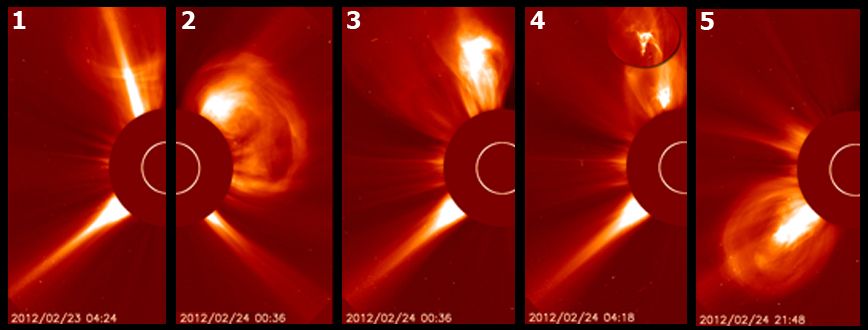Sun Unleashes 5 Solar Eruptions in 2 Days

Things on the sun have certainly been heating up. Our closest star unleashed five solar eruptions in only two days last week, producing extraordinary northern lights displays for lucky skywatchers over the weekend.
The solar storms flared up between Feb. 23 and 24 and exploded from nearly all areas of the star, including the top, bottom, left and right sides of the solar disk as seen by space-based observatories, according to NASA scientists. In fact, four of these outbursts came within a single 24-hour period.
One of the eruptions churned out an impressive magnetic filament in the early hours of Feb. 24. This triggered the first of two coronal mass ejections (CMEs) that were blasted toward Earth. CMEs are massive eruptions of solar plasma and charged particles that can produce potentially harmful geomagnetic storms when the they hit Earth's magnetic field lines.
Scientists closely monitor these events because the most powerful geomagnetic storms can disrupt satellites in orbit, cause communications interference, and damage other electronic infrastructure. But, one of the less harmful effects of geomagnetic storms is that they can amp up normal displays of Earth's auroras (also known as the northern and southern lights).
The Feb. 24 eruption was captured in a video by NASA's Solar Dynamics Observatory. The filament, which is visible in the extreme ultraviolet wavelength, shoots out from the sun, sending clouds of plasma into space.
Filaments are strands of darker, cooler solar material that hover above the surface of the sun by magnetic forces, NASA scientists explained.
The CME from the Feb. 24 solar eruption was weak, however, and did not set off a strong geomagnetic storm, NASA scientists said. After traveling through space, the CME hit Earth's magnetic field on Feb. 26 at 4 p.m. EST (2100 GMT).
Sign up for the Live Science daily newsletter now
Get the world’s most fascinating discoveries delivered straight to your inbox.
While the CME did not pack much of a punch, skywatchers at high latitudes were treated to stunning auroras on Feb. 26. Beautiful celestial light shows were reported were reported in Scandinavia and elsewhere around the Arctic Circle, according to website Spaceweather.com.
This story was provided by SPACE.com, a sister site to LiveScience. Follow SPACE.com for the latest in space science and exploration news on Twitter @Spacedotcom and on Facebook.













